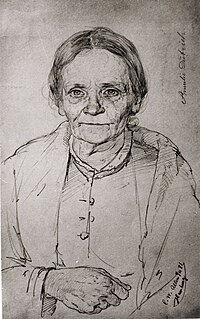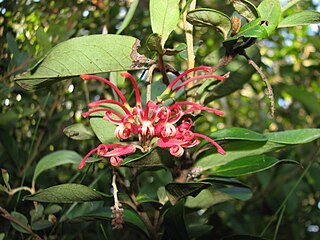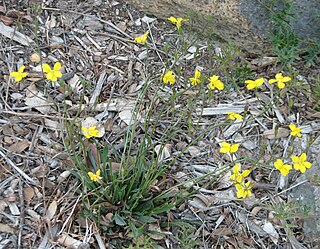Related Research Articles

Epacris impressa, also known as common heath, is a plant of the heath family, Ericaceae, that is native to southeast Australia. French botanist Jacques Labillardière collected the species in 1793 and described it in 1805. Four forms have been identified, but no subspecies are recognised. Growing in heathland, shrubland or open forest, it is generally a small shrub around 0.5 to 1 m tall, with small stiff leaves. The red, pink or white tube-like flowers appear from late autumn to early spring. Honeyeater birds, particularly the eastern spinebill, feed upon the nectar of the flowers. It regenerates after bushfire by seed or by resprouting.

Baron Sir Ferdinand Jacob Heinrich von Mueller, was a German-Australian physician, geographer, and most notably, a botanist. He was appointed government botanist for the then colony of Victoria (Australia) by Governor Charles La Trobe in 1853, and later director of the Royal Botanic Gardens, Melbourne. He also founded the National Herbarium of Victoria. He named many Australian plants.

Koncordie Amalie Dietrich was a German naturalist who was best known for her work in Australia from 1863 to 1872, collecting specimens for the Museum Godeffroy in Hamburg.

Otto Wilhelm Sonder was a German botanist and pharmacist.

The National Herbarium of Victoria is one of Australia's earliest herbaria and the oldest scientific institution in Victoria. Its 1.5 million specimens of preserved plants, fungi and algae—collectively known as the State Botanical Collection of Victoria—comprise the largest herbarium collection in Australia and Oceania.

Porpolomopsis lewelliniae, commonly known as the mauve splitting wax-cap, is a gilled fungus of the waxcap family found in wet forests of eastern Australia and New Zealand. The small mauve- or lilac-coloured mushrooms are fairly common and appear in moss or leaf litter on the forest floor in autumn, and are biotrophic. The key distinguishing feature is the splitting of the cap dividing down the middle of the individual gills.

Melaleuca pityoides, commonly known as alpine bottlebrush, is a plant in the family Myrtaceae, and is endemic to the higher areas of south eastern Australia. Some Australian state herbaria continue to use the name Callistemon pityoides. It is a shrub, often occurring in dense thickets, with hard bark, silvery-grey new growth, almost cylindrical leaves and spikes of flowers that are usually a shade of yellow.

Goodenia macmillanii, commonly known as pinnate goodenia, is a species of flowering plant in the family Goodeniaceae and is endemic to Victoria, Australia. It is an erect, short-lived perennial shrub with lyrate or lobed leaves, egg-shaped to elliptic in outline with toothed edges, and leafy racemes of bluish-purple flowers.

Grevillea miqueliana is a species of flowering plant in the family Proteaceae and is endemic to Victoria in Australia. It is an erect to spreading shrub with elliptic to egg-shaped leaves and clusters of red and orange or yellow flowers.
Johann Freiderich Carl Wilhelmi (1829–1884) was a Dresden born seedsman who made large collections of botanical specimens in southern Australia.

Goodenia lineata, commonly known as Grampians goodenia, is a species of flowering plant in the family Goodeniaceae and is endemic to the Grampians in Victoria, Australia. It is an erect perennial herb with lance-shaped, more or less toothed leaves with the narrower end towards the base and racemes of yellow flowers.
Muelleria is a peer-reviewed scientific journal on botany published by the Royal Botanic Gardens Melbourne. It focuses on topics relating to plants, algae, and fungi in the southern hemisphere and Australia in particular. The journal was named in honour of Victorian Government botanist Ferdinand von Mueller. Muelleria commenced publication in 1955 with funding from the Maud Gibson Trust. The trust was initiated in 1945 following the donation of £20,000 by Maud Gibson, a daughter of William Gibson, founder of the Foy & Gibson department store chain.
Alexander Clifford Beauglehole was an Australian farmer, botanist, plant collector and naturalist.

Joachim Steetz was a German botanist. His herbarium, comprising more than 5000 specimens from over 160 collectors and 30 countries was purchased in 1863 by Victorian Government Botanist Ferdinand von Mueller for the sum of 80 pounds. The collection is currently housed at the National Herbarium of Victoria. The herbarium was compiled by Steetz over more than thirty years and comprises 160 collectors from more than 30 countries, including type specimens from plant collectors of the time including:

Mary Harriet Bate was an Australian collector of botanical specimens for Australian botanists, especially the German-Australian Ferdinand von Mueller. Her contributions were recognised in the names of several species.
Helen Isobel Aston was an Australian botanist and ornithologist.

Boronia adamsiana, commonly known as Barbalin boronia, is a plant in the citrus family, Rutaceae and is endemic to a small area in the south-west of Western Australia. It is an erect, hairy shrub with trifoliate leaves and pink or white, four-petalled flowers.

Mary Ann McHard (1825–1912), née Jones, was a pioneering Western Australian woman who contributed to Australian botany by collecting over 2000 plant specimens for Ferdinand von Mueller and sending them to the newly created National Herbarium of Victoria.

Goodenia pusilliflora, commonly known as small-flower goodenia, is a species of flowering plant in the family Goodeniaceae and is endemic to drier parts of southern Australia. It is a low-lying to ascending herb with oblong to egg-shaped leaves with toothed or lyrate edges, and racemes of small yellow flowers.
Louisa Isabella Chaulk Baudinet, also known as Lucy Baudinet or Miss Baudinet was an Australian botanical collector.
References
- 1 2 3 4 "Campbell, Flora Mary - biography". www.anbg.gov.au. Retrieved 13 December 2020.
- 1 2 3 4 Maroske, Sara (2018). "On the threshold of mycology: Flora Martin née Campbell (1845–1923)" (PDF). Muelleria. 36: 51–73. doi:10.5962/p.291974. S2CID 251005678.
- 1 2 3 Maroske, Sara (2014). "'A taste for botanic science': Ferdinand Mueller's female collectors and the history of Australian botany". Muelleria. 32: 72–91. CiteSeerX 10.1.1.695.7872 . doi:10.5962/p.295689. S2CID 162606629.
- ↑ Ltd, August Pty. "The Essence of Insult – Flora Campbell (1845-1923)". www.rbg.vic.gov.au. Retrieved 13 December 2020.